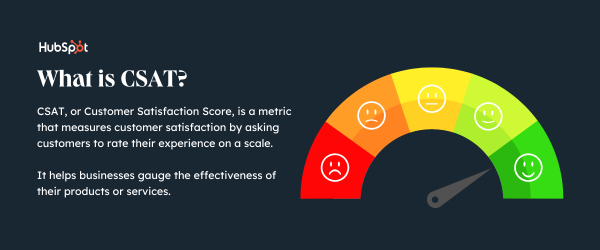You know you should be measuring customer satisfaction, but it can be daunting to choose the right methodology. So, where do you start?

To simplify your choice, we'll cover one of the most popular types of satisfaction surveys: Customer Satisfaction Score (CSAT). We'll dive into what a CSAT survey measures, when to use it, and how you should leverage it. And if you're in a pinch, jump straight to the information you need.
- What is CSAT?
- CSAT Calculation
- What is a good CSAT score?
- When should you use CSAT?
- CSAT Pros and Cons
→ Download Now: Customer Service Metrics Calculator [Free Tool]
What is customer satisfaction score (CSAT)?
Customer Satisfaction Score (CSAT) measures customer satisfaction with a business, purchase, or interaction. It’s one of the most straightforward ways to measure customer satisfaction, and it's obtained by asking a simple question, such as 'How satisfied were you with your experience?' To answer, there's a corresponding survey scale, which can be 1 – 3, 1 – 5, or 1 – 10.

Learning how to calculate Customer Satisfaction Score is also quick and straightforward.
Customer Satisfaction Score Calculation
A CSAT score is the sum of all positive responses, divided by the total responses collected, then multiplied by 100. The outcome leaves you with the overall percentage of satisfied customers at your business.
For example, if you received 25 total responses and 15 of them were positive — your CSAT score would be 60% (15 positive responses / 25 total responses = .60 x 100 = 60%).
This indicates that most people are satisfied with your offering, but also highlights that there’s much more room for improvement.
These calculations can be pulled from surveys like the example below. Taking the number of positive (5 - 7) responses from the total responses collected.
%3F-1.png?width=600&name=What%20Is%20Customer%20Satisfaction%20Score%20(CSAT)%3F-1.png)
If the resulting number isn't satisfactory, there are proven ways to improve your CSAT score. To aid in that process, you can track customer satisfaction across the customer lifecycle very simply using Customer Satisfaction Score.
Since it's a quick survey, you can ask it across multiple experiences during a customer's journey and get a big-picture view of how your customer feels at various touchpoints during the process. This makes it easier to find potential bottlenecks and improve the customer experience.
%3F.png?width=519&height=407&name=What%20Is%20Customer%20Satisfaction%20Score%20(CSAT)%3F.png)
What is a good customer satisfaction score?
While CSAT scores vary by industry, a good score typically falls between 75% and 85%. Since CSAT measures only your promoter scores, obtaining a near-perfect score is difficult. Having a score of 75% means that three out of every four customers gave you a positive score instead of a negative or neutral one.
To see some real-life examples of customer satisfaction scores, let’s look at the average CSAT scores across different industries.
CSAT Score By Industry
Below are industry benchmarks for CSAT score, according to the American Customer Satisfaction Index.
- Apparel: 79
- Automobiles and Light Vehicles: 78
- Banks: 78
- Breweries: 81
- Cell Phones: 79
- Computer Software: 76
- Consumer Shipping: 76
- Credit Unions: 77
- Financial Advisors: 77
- Full-Service Restaurants: 79
- Hotels: 73
- Internet Retail: 78
- Internet Travel Services: 74
- Life Insurance: 78
- Specialty Retail Stores: 77
Now that you've seen typical CSAT scores, let’s discuss when you should use them.
You can manage feedback and improve the CSAT scores for your business by using tools like HubSpot’s Customer Service Software. With this tool, you can effectively create CSAT survey forms for your customers and use the insights to understand which areas of your business need improvements..png)
Customer Satisfaction Score Calculator
Calculate your business's key metrics and KPIs for customer support, service, and success with this free template.
- Customer Acquisition Cost
- Customer Lifetime Value
- Customer Satisfaction Score
- And More!
Download Free
All fields are required.
.png)
When should you use customer satisfaction score?
1. After customer lifecycle moments.
Best for: During onboarding and post-purchase stages.
CSAT ties customer satisfaction surveys to key moments in a customer's experience. That way, you can connect your customer insights to business questions and measure the effectiveness of key moments, like user onboarding.
This is how Nils Vinje, VP of Customer Success at Rainforest QA, puts it:
"The best time to send a customer satisfaction survey is after a meaningful part of the customer lifecycle is completed. For example, sending a satisfaction survey at the end of the customer's onboarding will help you capture valuable feedback on how to improve the onboarding experience.
At this point, the customer likely has made up their mind on whether or not your solution solves their problem, and if it doesn't, you need to know that — ASAP."
2. Prior to renewal.
Best for: Six months before subscription renewal.
Vinje also suggests another important checkpoint to send a satisfaction survey: six months before renewal.
"The reason I like the six-month mark is that it gives you enough time to act on the feedback before you get into the renewal phase of the customer's subscription. You can always do something about a problem that you know about, but you can't do anything about a problem you don't know about."
To his second point, you can also trigger CSAT surveys on a time-based schedule.
Because of the simplicity of the Customer Satisfaction Score, it makes it easy to conduct this survey multiple times and at multiple touchpoints (not simply at the end of important experiences).
For this reason, it's important to pop the question often and on a rolling basis — like Matt Hogan, VP of Customer Success at Intricately, recommends:
"Deploying customer satisfaction surveys on a rolling basis will keep the constant feedback loop going. The technology available makes it easy to manage this. This way, you're getting a sense of people's feelings when you're not releasing products or doing anything different.
Most companies do this after releasing features or on a controlled schedule, which will influence your responses."
3. After customer support or education interactions.
Best for: After customer demos, troubleshooting, follow-up.
Finally, Customer Satisfaction Score may be used directly after customer support or customer education touchpoints.
For example, asking a single satisfaction question after a customer finishes reading a knowledge base article can help you gauge how effective it was.
In summary, you can use CSAT surveys at any point where you hope to measure customer sentiment — during the sales process, while using the product, or while interacting with your content.
However, because of the nature of the question, the response will skew towards a customer's immediate experience and reaction. Therefore, these findings shouldn't be taken as insight into the broader customer experience or brand perception.
Let’s explore a few more pros and cons of CSAT in the section below.
Customer Satisfaction Score Pros & Cons
Any survey methodology has advantages and disadvantages, and Customer Satisfaction Score is no exception.
CSAT Pros
A few advantages of using CSAT include:
- It’s short, intuitive, and simple to use.
- The rating scale can vary based on the context, giving you the flexibility to use what works best for your audience from stars, emojis, or numeric rating scales.
- CSAT generates higher response rates than other satisfaction surveys because there are fewer questions.
CSAT Cons
Possible disadvantages of using CSAT include:
- There’s a potential for cultural bias: An article inPsychological Science showed that people in individualistic countries choose the more extreme sides more frequently than those in collectivistic countries (for instance, an American is more likely to rate service as "amazing" or "terrible" than someone from Japan, who will stick to "fine" or "not satisfactory.")
- There’s some ambiguity in what a good or a bad score is because of wide-ranging benchmark data across industries and companies.
- CSAT reflects short-term sentiment. E.g. it's based on the last touchpoint a customer had with our company and how they're feeling on a given day (this might not be a downside given your goals).
- "Satisfaction" is a subjective word, and "satisfied" may mean different things to different people.
- Customers in the "neutral" and "dissatisfied" categories often don't fill out surveys, creating a higher potential for skewed results.
Perhaps the biggest downside of CSAT is the most fundamental: Who wants to optimize for "satisfaction?” Unless this is a leading indicator of a metric of actual importance at your company (lifetime value, retention, activation, etc.), aiming for just "satisfied" feels a bit underwhelming.
Nobody puts it better than Jared Spool, founder of UIE, who once said:
"I'm going to give you a list of attitudinal words ... [and ] I want to see if you can pick out the one that's a little different than the rest. I've got ‘delightful,’ ‘amazing,’ ‘awesome,’ ‘excellent,’ ‘remarkable,’ ‘incredible,’ and ‘satisfactory.’ Which word is different from the others?
...Yes, satisfactory. Why is that word different? Well, if we were talking about a restaurant we loved, would we say, ‘Wow, that was incredibly satisfactory?’
No. We'd use something like delicious. Satisfactory is this neutral word. It's like edible. No one raves about a restaurant that is edible. ‘Oh my God, you should've gone to this place we went to last night. It was extremely edible!’
We've set ourselves a low bar. [And] we can do so much better."
CSAT Example
To get a better understanding of a typical Customer Satisfaction Score survey, let’s use an example. Think about the type of information a property management company would like to know after a resident requests a maintenance order.
%3F-2.png?width=624&name=What%20Is%20Customer%20Satisfaction%20Score%20(CSAT)%3F-2.png)
In this example, the scale is from “Poor” to “Excellent”. This may look simple, but the responses collected can mean different things according to the most prevalent components.
If a resident were to respond with a rating on the higher end like “Good” or “Excellent”, they’re considered evangelists. They found their experience with the maintenance staff to have met their expectations, solved their problem, and left them feeling satisfied. Residents can tell you what went exceptionally well and become word-of-mouth advocates and encourage others looking for an apartment with reliable staff, too.
On the other hand, if they provided a rating of “Poor,” “Fair,” or “Average,” they’re considered detractors. These are residents who felt they had a negative experience with maintenance. This survey itemized each aspect of the visit — like quality or cleanliness — so the resident can inform the company of what went wrong.
Enough collected surveys can act as a guide to address areas in need of improvement. It’s also important to look at your CSAT score over time to assess patterns as opposed to focusing on isolated or uncommon occurrences.
Your Customer Satisfaction Score Leads to Success
In that regard, measuring something tangible — like if the customer would recommend you to a friend — at least gets to something worth attaining. After all, a great experience is a recommendable one. But just a satisfactory experience? Maybe not — so let's aim beyond simply satisfactory. And that's what customer success is all about.
Editor's note: This post was originally published in June 2020 and has been updated for comprehensiveness.
.png)
Free Customer Service Metrics Calculator
Calculate your business's key metrics and KPIs for customer support, service, and success with this free template.
- Customer Acquisition Cost
- Customer Lifetime Value
- Customer Satisfaction Score
- And More!
Download Free
All fields are required.
.png)



![23 Excellent Customer Satisfaction Survey Examples [+ Templates]](https://www.hubspot.com/hubfs/customer-satisfaction-survey-example_0.webp)




![After Sales Service Strategy: What It Is & Why It's Important [+Examples]](https://www.hubspot.com/hubfs/after-sales-service.jpg)
![How To Design Customer Satisfaction Surveys That Get Results [+ Templates]](https://knowledge.hubspot.com/hubfs/customersatisfactionsurvey.webp)